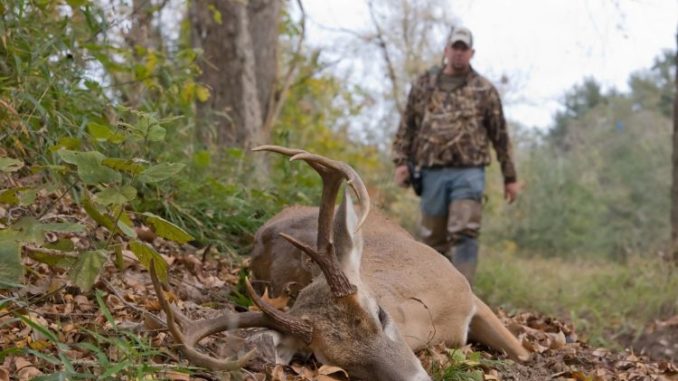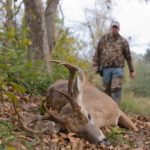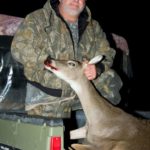
As the rut progresses at varying rates across the state, big bucks can become even more elusive as hunting pressure mounts. Try these tips to knock down a big December deer.
While December may be the chronological middle of the road for Louisiana’s deer season, it could be the beginning, middle or end of your season depending on where you hunt as it pertains to the stages of the rut.
That’s because the main breeding period could be completely over in one part of the state during December — while it’s just getting started in other areas.
In Southwest Louisiana, where bass tournament pro Dennis Tietje spends his down time chasing deer, December means he’s hunting the very back end of the rut.
“Our rut where I hunt in Beauregard Parish starts the first week of November and is wrapping up by December,” he said. “It can get a little tricky hunting this time of year, but I’ve killed two of my biggest deer during December, so it can be done with a little determination.”
By this time of the season, hunting pressure has been rampant enough to force deer to go just about completely nocturnal. Since the bucks aren’t out chasing does all that much, there’s no real reason for them to be out and about during daylight.
But according to Tietje, December bucks still have a few does left to breed and they still have to eat — although they mostly like to stay hidden.
“All that stuff about nocturnal deer is true,” Tietje went on, “but it really only affects if you’re still trying to hunt bucks like you did during the middle of the rut. Simply put, these deer aren’t going to come to you; you’re going to have to go to them. You might even be surprised by what kind of bucks you find slinking around during the day.”
Focus on food
For Tietje, having successful December deer hunts means focusing on three things — food, cover and leftover girls.
While the hog population has done a number on hard mast lying on the ground in Southwest Louisiana, Tietje believes that where he can find acorns, he’s found the most natural food source available.
“And hunting in December around here means staying as natural as you can, so you don’t alert those big bucks to your presence,” he said. “If you’ve got some good acorns around, you can bet deer will be eating them over any other food source around.”
The inference here is to stop relying on a golden pile of corn during December. Deer presumably have become conditioned to avoid corn piles during shooting hours because they associate them with danger.
“We have to travel into our hunting areas every time we put corn out,” Tietje said. “And every time you do that you’re stinking up the place. Deer know we don’t go to our corn piles at night, so that’s exactly when they go.”
Second to a good crop of acorns is a well-fertilized food plot.
“That’s the next best thing,” Tietje went on. “If it’s taken care of and you limed your soil and poured the fertilizer to it, a good food plot can provide deer with everything they need during December. The fact that those greens are so nutritious is what makes a good foot plot so attractive.”
Tietje has found that plain winter wheat is a great choice in Southwest Louisiana. Although he’s tried turnips before, he just doesn’t feel like Louisiana winters get cold enough to turn the sugars in the plant.
“I’ve planted them, and the deer wouldn’t touch them,” he said. “Then I’d go hunt with some friends in Illinois where they hammer the turnips… standing there with a big old head of turnips in their mouths just tearing them up. That doesn’t happen in Beauregard Parish — at least not in my experience.”
While hunting over acorns can be good any time during December, Tietje has found that hunting his food plots is more productive on the coldest days.
All he can figure is that maybe deer need the nutrition more on the cold days as opposed to when it’s warmer and they aren’t burning as many calories trying to stay warm.
Head for cover
While food is an important consideration for December deer hunting, Tietje says the best food sources will be next to another one of his most important considerations — cover.
“You’ve got to get really close to the thickets,” he insisted. “They’re not going to be out in the open much during December… at least during the day. Thickets make them comfortable, so you’re going to have to make sure you’re at least near one if not actually in one.”
Where Tietje hunts in Beauregard Parish, he considers a good thicket to be about 8-year-old pine plantations that haven’t been thinned out yet. These pines generally have very thick underbrush, which is extremely important during December.
Putting trail cams on trails in the thickets rather than over a pile of corn has proven to Tietje that big bucks feel comfortable enough in thickets to move about during the day.
“And the thing about those trails in the thickets is that big 8-point you saw on it one day typically shows up again the next,” Tietje said. “Around here they frequent the same trails a lot when they get comfortable moving along one.”
Before December, these deer that walk the same trail over and over can be hard to pinpoint since they can be on one trail one day and another trail 300 yards north of it the next.
Because their food sources are still so broad and they’re chasing does all over the parish, deer don’t have to go back to the same area over and over again.
“Everything’s a lot tighter this time of year,” Tietje noted. “They’ll get locked on whatever food source they can find and stick tight to the thickets. You’re right these deer go nocturnal this time of year, but if you’re in the right spot you can see some of the biggest bucks of your life on their feet during shooting hours.”
To hunt these tighter areas, Tietje locates where trails cross a slight open area within the thicket, and uses a climbing stand to shimmy up a tree. This gives him a good line of sight to the trail — without being in the line of sight of deer walking on the trail.
“I’ve tried hunting on the ground with little success,” he added. “Seems like… especially in those tight areas… that I get busted all the time when I’m not up a tree.”
Take does sooner rather than later
Although December is the tail end of the rut in Beauregard Parish, there are some does that weren’t bred during the main part of the rut. It is those does that act as live decoys for the big bucks.
This is why Tietje is adamant about taking his does early in the season rather than during or after the rut.
“You don’t want to be shooting does in December; I promise you,” he said. “If any of those does you see weren’t already bred, you can bet there’s a buck somewhere nearby, and he ain’t coming out if you shoot his girlfriend.”
The yearling crop of does in Southwest Louisiana typically don’t get bred until late in the season. Tietje says they will breed at six months, and that doesn’t happen until December and January.
“Back in late October I got a picture of a spotted fawn on my trail cam,” he said. “It looked like a deer we would typically see during June. That was a yearling doe that was the result of a another yearling deer that was bred near the end of last season.”
Write it down
Perhaps the biggest key to Tietje’s December success is the meticulous records he has kept for years.
“You’ve got to be aware of your own area,” he said. “You’ve got to know what the major rut cycles are where you hunt. Rut calendars can be good, but they are no match for your own individual journal for the exact spot you hunt.”
Because he has hunted the same areas all his life, Tietje can pinpoint the peak of the rut within a two-week period any year. A lot of it depends on the temperature, but he can tell you it’s going to be a week before or a week after the prime time recorded in his journals.
As for keeping a journal of your own? If you’ve never started one, there’s no time like the present. What’s the old adage about planting a tree? The best time to plant a tree was 20 years ago — the second best time is today.
“I think you’re going to find that keeping your own hunting journal will go a long way to you ultimately being able to learn exactly what the deer do on your place,” Tietje concluded. “It may take a few years to build up a good database, but once you get it, you’ll wonder how you ever hunted without keeping one.”
December doesn’t mean you have to hang it up until next year if your deer are on the tail end of the rut. Try Tietje’s tips for yourself and see if they don’t help put you down an extra buck or two.





